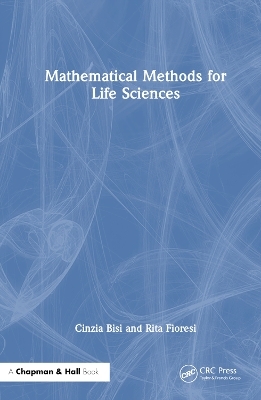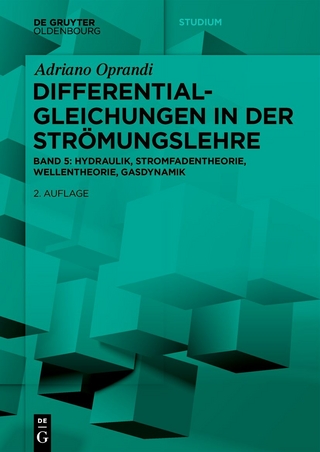
Mathematical Methods for Life Sciences
Chapman & Hall/CRC (Verlag)
978-1-032-36229-8 (ISBN)
Mathematical Methods for Life Sciences introduces calculus, and other key mathematical methods, to students from applied sciences (biology, biotechnology, chemistry, pharmacology, material science, etc). Special attention is paid to real-world applications, and for every concept, many concrete examples are provided. The book does not aim to enable students to prove theorems and construct elaborate proofs, but rather to leave students with a clear understanding of the practical mathematics behind the power of optimization, dynamical systems, and all the predictive tools these theories give rise to.
Features
No prerequisites beyond high school algebra and geometry
Could serve as the primary text for a first-year course in mathematical methods for biology, biotechnology, or other life sciences
Easy to read: the students may skip all the proofs and go directly to key examples and applications
Cinzia Bisi is a Professor of Geometry at the Department of Mathematics and Computer Sciences at the University of Ferrara, Italy. She has wide experience in teaching mathematics and statistics to students in the Department of Life Sciences. She has an interest in the areas of pure and applied mathematics. Rita Fioresi is a professor of Geometry at the FaBiT Department at the University of Bologna, Italy. She has written textbooks in linear algebra, and her research interests are primarily in the areas of pure and applied mathematics.
1. Functions in applied sciences. 1.1. The concept of function. 1.2. Linear functions. 1.3. Polynomial functions. 1.4. Rational functions and algebraic functions. 1.5. The exponential and logarithmic functions. 1.6. Malthusian Law. 1.7. Elementary trigonometric functions. 1.8. Exercises with solutions. 1.9. Suggested Exercises. 2. Limits and Derivatives. 2.1. Limits. 2.2. Properties of limits and standard limits. 2.3. Indeterminate forms. 2.4. Continuity. 2.5. Derivative of a function. 2.6. Derivability and Continuity. 2.7. De L’Hopital’s Rule. 2.8. Derivative of the Inverse Function. 2.9. Exercises with solutions. 2.10. Suggested Exercises. 2.11. Appendix: Derivation rules. 2.12. Appendix: Derivatives. 2.13. Appendix: Theorems on limits. 3. Applications of the derivative. 3.1. The linear approximation. 3.2. The derivative as rate of change. 3.3. Local Maxima and Minima. 3.4. Graph sketching. 3.5. Optimization. 3.6. Exercises with SolutionsSuggested Exercises. 3.7. Appendix: Theorems of differential calculus. 4. Integrals. 4.1. The Definite Integral. 4.2. Properties of the definite integral. 4.3. The Fundamental Theorem of Calculus. 4.4. Integration by substitution. 4.5. Integration by parts. 4.6. Integration of rational functions. 4.7. Integration of trigonometric functions. 4.8. Applications. 4.9. Exercises with solutions. 4.10. Suggested Exercises. 4.11. Appendix: Indefinite integrals. 4.12. Appendix: Theorems on integral calculus. 5. First order differential equations. 5.1. First order equations. 5.2. The Cauchy problem. 5.3. Direction field. 5.4. Separable Equations. 5.5. Newton’s law of cooling. 5.6. Linear equations. 5.7. Mixing problems. 5.8. Malthusian laws and population dynamics. 5.9. Homogeneous equations. 5.10. Autonomous differential equations. 5.11. The Logistics Model. 5.12. Solution of the logistic equation. 5.13. Exercises with solutions. 5.14. Suggested exercises. 6. Second order differential equations. 6.1. Cauchy’s Theorem. 6.2. The Wronskian. 6.3. Homogeneous linear equations. 6.4. Linear equations. 6.5. Linear equations with constant coefficients. 6.6. Equations with constant coefficients: the general case. 6.7. Simple harmonic motion. 6.8. Harmonic motion with external force. 6.9. Damped harmonic motion. 6.10. Exercises with Solutions. 6.11. Suggested Exercises. 6.12. Appendix: Linear Systems. 7. Elementary Statistics. 7.1. Populations and Variables. 7.2. Absolute Frequencies and Percentages. 7.3. Graphical representation of data. 7.4. Mode, Average, and Median. 7.5. Variance and standard deviation. 7.6. Quartiles and Interquartile Range. 7.7. Normal Distribution. 7.8. Exercises with solutions. 7.9. Suggested Exercises. A. Solutions of some exercises.
| Erscheinungsdatum | 23.01.2024 |
|---|---|
| Zusatzinfo | 63 Line drawings, black and white; 63 Illustrations, black and white |
| Sprache | englisch |
| Maße | 156 x 234 mm |
| Gewicht | 612 g |
| Themenwelt | Mathematik / Informatik ► Mathematik ► Analysis |
| Mathematik / Informatik ► Mathematik ► Angewandte Mathematik | |
| ISBN-10 | 1-032-36229-4 / 1032362294 |
| ISBN-13 | 978-1-032-36229-8 / 9781032362298 |
| Zustand | Neuware |
| Haben Sie eine Frage zum Produkt? |
aus dem Bereich


